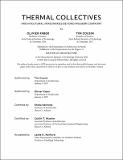| dc.contributor.advisor | Kennedy, Sheila | |
| dc.contributor.advisor | Mueller, Caitlin T. | |
| dc.contributor.author | Cousin, Tim | |
| dc.contributor.author | Faber, Olivier | |
| dc.date.accessioned | 2023-03-31T14:41:49Z | |
| dc.date.available | 2023-03-31T14:41:49Z | |
| dc.date.issued | 2023-02 | |
| dc.date.submitted | 2023-02-28T18:51:17.858Z | |
| dc.identifier.uri | https://hdl.handle.net/1721.1/150238 | |
| dc.description.abstract | The era of abundance is over.
The urgent need for CO2 emission reductions, combined with the rising price of energy and building materials, as well as restrictions on construction waste, call for alternative modes of building and inhabiting our cities.
The notion of “comfort” implies practices of consumption that have shaped our cultural and sensorial experience of domesticity. But “modern comfort”, the one we know today, is a recent construct that was shaped in the aftermath of the post-war economic boom. Modern comfort is characterized by the transition from the tactical heating of human bodies in space to the global and uniform conditioning of spaces themselves —at all times and across all seasons. This was rendered possible by the development of fuel intensive HVAC systems and supported by complex curtain wall envelopes that have resulted in the industry-wide abandonment of thermal intelligence and its associated material practices.
In a near future context of fuel scarcity, a group of people come together to confront the rising difficulty of maintaining their comfort. Their vision for living together in an alternative mode of dwelling calls for new forms of abundance in a world of scarcity, achieved through thermal intelligence. Their manifesto outlines the following fundamentals:
• Living with thermal properties and climate
• Collectivizing living spaces
• Applying thermal intelligence to material ethics in construction and maintenance.
The group surveys the numerous stranded modern office buildings on the outskirts of Paris. They acquire one of them at a bargain, and commission an experienced thermal architect to design the major spatial and infrastructural rearrangements to unlock the building’s passive thermal capacity. In support of the Thermal Collective’s new way of dwelling, the residents share their skills and build and maintain the interior fit out. We will follow the stories of some of the inhabitants as they construct, live in and care for their Thermal Collective. | |
| dc.publisher | Massachusetts Institute of Technology | |
| dc.rights | In Copyright - Educational Use Permitted | |
| dc.rights | Copyright retained by author(s) | |
| dc.rights.uri | https://rightsstatements.org/page/InC-EDU/1.0/ | |
| dc.title | Thermal Collectives Architectural Imaginaries Beyond Modern Comfort | |
| dc.type | Thesis | |
| dc.description.degree | M.Arch. | |
| dc.contributor.department | Massachusetts Institute of Technology. Department of Architecture | |
| mit.thesis.degree | Master | |
| thesis.degree.name | Master of Architecture | |
